Robert Bell's
Wines of Canada
Since 1992

Grape Varieties in Quebec
Québec's cottage wineries produce mainly white wines (80% white, 20% red), mostly very fresh Seyval Blanc. Vidal, Chardonnay, Riesling, Aurore, Cayuga, Ortega, Bacchus and the Geisenheim 318 clone are also grown. In reds, de Chaunac, Marechal Foch, Gamay, Cabernet Franc, Chancellor, Vidal Noir and Dornfelder are grown.
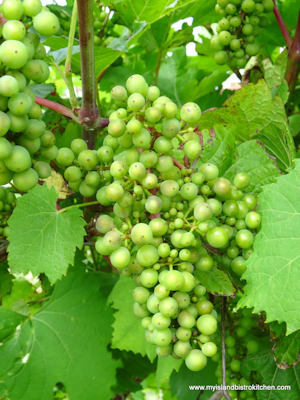 |
Acadie Blanc
Native to the Niagara Valley in Ontario, Acadie blanc is a white grape variety widely planted in Nova Scotia with some plantations in Quebec and Ontario. It is named in honor of the rich Acadian culture.
Even though it must be protected from extreme cold, this variety is well appreciated by winegrowers. Acadie blanc is easy to grow because it is an upright variety (i.e. the branches of the vines do not fall to the ground and they are therefore more solid, less susceptible to breakage associated with wind), it is not very susceptible to diseases, offers good yields and matures rather hastily.
Acadie blanc offers good still and sparkling white wines; dry wines with flavors of peaches, honeydew melon and pineapple.
Origin:Acadie Blanc was created in 1953 in Niagara, Ontario, at the Vineland research station. The grape has been revealed to have members of eight different species of Vitis, including Vitis aestivalis, Vitis berlandieri, Vitis cinerea, Vitis labrusca, Vitis lincecumii, Vitis riparia, Vitis rupestris, and Vitis vinifera.
|
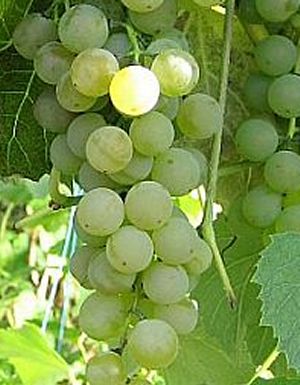 |
Adalmiina (Es6-6-30)
Could have been named “northern Muscadet”, because their wines are very similar.
The hardiness can be very good, but unstable. Semi-late bud burst. Moderately vigorous, semi-drooping growth habit; excessive development of lateral shoots. Overripe, the berry skin is prone to cracking and rotting. Good resistance to disease. This early variety needs a good site, a maritime climate, or a site with heavy snow.
|
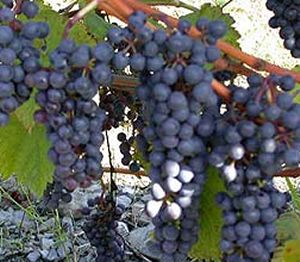 |
Baco Noir
Known for producing a dark, rich, and robust red wine, Baco Noir is a French-American hybrid red wine grape with origins dating back to the late 1800’s. Discovered by French grape breeder François Baco, it’s a cross between Folle Blanche and an unknown member of the New World’s Vitis Riparia family. It eventually made its way over to North America and can now be found in both Canada and the United States. Since it benefits from cool growing temperatures, you will find Baco Noir across Ontario and in States such as New York, Michigan and Oregon.
Baco Noir has an attractive, deep colour tint. Medium to light bodied, this grape has rustic aromas with notes of cherry and smoke. Baco Noir explodes with flavour, its lush fruit tones of mixed berries and plum are complemented by herbal notes. Often aged because of its juicy acidity, it has a refreshing and persistent finish.
Baco Noir quickly became one of North America’s most successful hybrids. Introduced in 1955, it is now one of Ontario’s most grown grapes. Its ability to survive harsh winters makes it the perfect fit for Ontario’s unpredictable climate. Its resistance makes it a friendly alternative to growing Pinot Noir.
In summary, Baco Noir has the following characteristics:
French-American hybrid red wine grape
Found in Ontario and in States such as New York, Michigan and Oregon
Produces dark, rich, robust red wine with an attractive deep tint
Medium to light bodied
Rustic aromas with notes of cherry and smoke
Lush fruit tones with mixed berries and plum flavours
Often aged because of acidity
Refreshing and persistent finish
One of North America’s most successful hybrids
One of Ontario’s most grown grapes
Ability to survive harsh winters
|
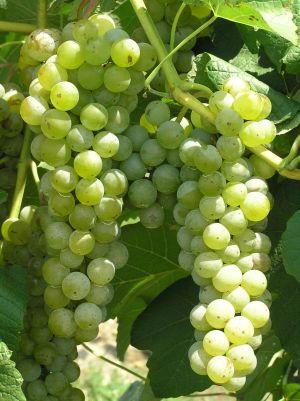 |
Cayuga
Cayuga White is a grape variety found mainly in the northeastern regions of the United States as well as in the Canadian provinces including Quebec! Versatile, it can make dry white wines, sparkling wines or late harvests.
Consumers appreciate it for its fragrant, musky and fine wines (Alsatian type). Most Cayuga White wines have notes of peaches, apples and tropical fruits.
Origin:Marketed since 1972, Cayuga White was developed from crosses of hybrid grape varieties Seyval Blanc and Schuyler, in New York State in the United States
|
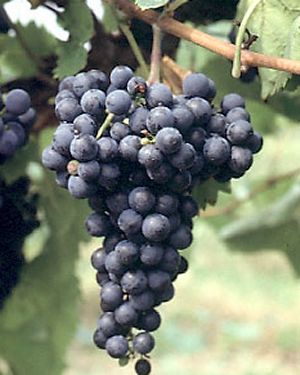 |
Chancellor
Chancellor grapes, also known as Seibel 7053 Chancellor, are a cross of Seibel 5163 and Seibel 880 and were developed in France. Despite their origins, these grapes are now grown almost exclusively in the United States and Canada, as they are highly productive in cold weather and do not perform well in humid and hot areas with low ventilation.
|
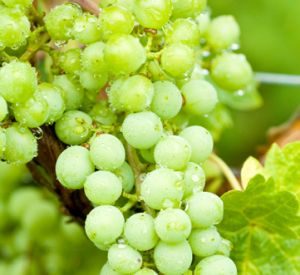 |
Chardonnay
Chardonnay grape is green-skinned and is believed to have originated in the Burgundy wine region of eastern France but is now grown all over the world wherever wine is produced. It is a relatively “low-maintenance” vine that adapts well to a variety of climates, resulting in fairly high yields worldwide In Canada they are best grown in British Columbia and Ontario.
Chardonnay has also been grown in Nova Scotia. Blomidon Estate Winery makes 100% gown Chardonnay. Gaspereau Vineyards is another Nova Scotia producer of Chardonnay along with their traditional method Chardonnay Brut sparkling wine.
Les Pervenches, near Farnham in Quebec's Eastern Townships was among the first in Quebec to grow Chardonnay. Taws in Ontario produces great Chardonnay and Chardonnay icewine.
Chardonnay's boast an impressive range of flavors from the expected buttered, oak overtones to the fresh, fruit flavors of apple, pear, tropical, citrus and melon, leaving a lasting palate impression.
|
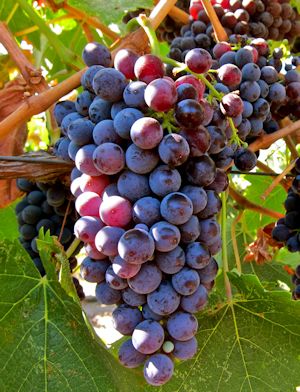 |
De Chaunac
De Chaunac is a French-American hybrid grape that is grown in the northeastern United States and Canada. It is a dark-skinned variety that ripens early in the season and has strong resistance to both forms of vineyard mildew. De Chaunac was one of the hybrid varieties created in France by Dr. Albert Seibel in the devastating wake of phylloxera in the latter half of the 19th Century.
Originally called Siebel 9549, the variety was later renamed after Adhemar de Chaunac, a French-Canadian immigrant who pioneered the growing of Vidal for ice wine production in Canada. He also introduced a number of hybrid grape varieties to North America, among which Seibel 9549 may well have been included.
Synonyms include: Siebel 9549.
|
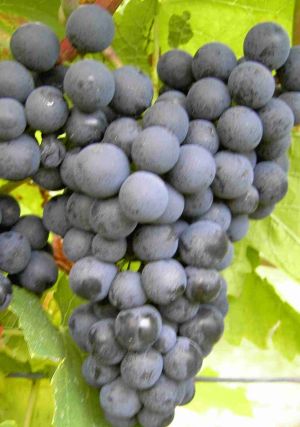 |
Dornfelder
Dornfelder : an immensely popular German red wine grape; a 1955 crossing of Helfensteiner (Frühburgunder × Trollinger) and Heroldrebe
De Vine on Vancouver Island produces a Dornfelder wine- ripe, fruity German red with intense color and an aroma of spruce tips and elderberries.
8th Generation Confidence Frizzante style uses 50% Dornfelder along with
Pinot Gris and Syrah
The Ice House winery in Ontario makes a Cabernet/ Dornfelder icewine.
Also grown in Quebec.
|
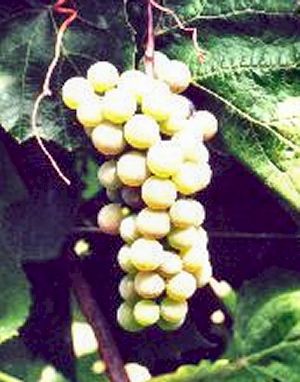 |
Eona
Very hardy grapevine cultivar, producing good amounts of larger white fruits, in mid-September. Good for: table and wine.
Vignoble Isle de Bacchus
Vignoble de Sainte-Petronille
|
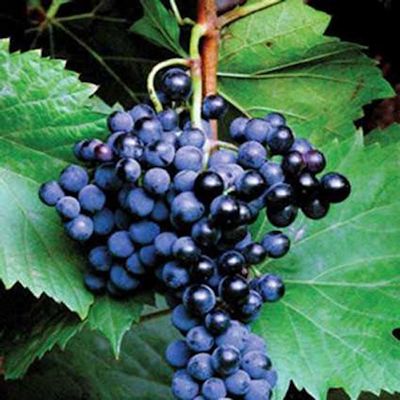 |
Frontenac
Frontenac is a dark-skinned, hybrid French-American grape variety, the result of a crossing made in 1978 between Landot Noir, and a native Vitis riparia vine noted for its resistance to the cold. It is the most widely planted red wine grape variety in its home state of Minnesota, and has recently enjoyed successin Quebec.
Read More
|
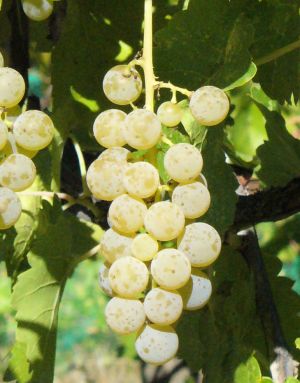 |
Geisenheim Gm318-57
White wine producing hybrid cultivar technically known as GM318-57 created in 1957. Reported as derived from Riesling cl.239 F2 and Chancellor parents . Moderately winter hardy. Susceptible to leaf burn from copper-containing sprays and fungus diseases such as Powdery Mildew. Usually ripens late September where successfully grown in Nova Scotia, Canada. A reportedly slightly hardier yet similar hybrid is the Jost (Geisenheim). A somewhat similar cultivar, currently grown on the south island of New Zealand, is a variety named Breidecker.
|
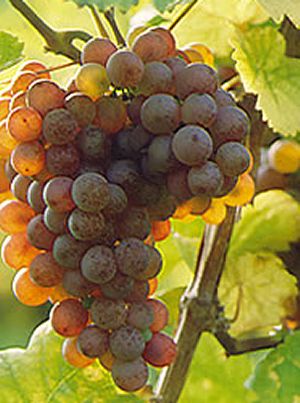 |
Gewürztraminer
Gewürztraminer is an aromatic wine grape variety, used in white
wines , and performs best in cooler climates. It is sometimes referred to colloquially as Gewürz . Gewürztraminer is a variety with a pink to red skin colour, which makes it a "white wine grape" as opposed to the blue to black-skinned varieties commonly referred to as "red wine grapes". The variety has high natural sugar and the wines are white and usually off-dry , with a flamboyant bouquet of lychees . Indeed, Gewürztraminer and lychees share the same aroma compounds .Dry Gewürztraminer's may also have aromas of roses, passion fruit and floral notes. It is not uncommon to notice some spritz (fine bubbles on the inside of the glass)
|
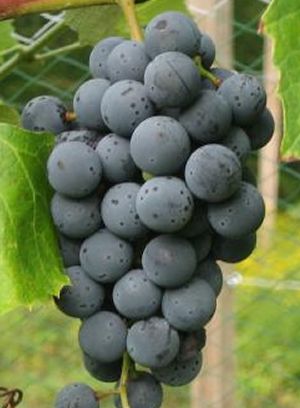 |
Landot Noir
Landot noiris a red hybrid grape variety that is a crossing of Landal and Villard blanc. Created after a series of trials between 1929-1949, the grape was introduced to Canada and the United States in the 1950s and today can be found in Quebec
In the 1970s, viticulturists at the University of Minnesota crossed Landot noir with a Vitis riparia vine that was growing wild near Jordan, Minnesota to create the hybrid grape variety Frontenac.
Landot noir was created by French grape breeder Pierre Landot from a series of trials conducted between 1929-1949 with vines growing in vineyard in Conzieu in the Ain department in eastern France. The vine was made a crossing between one of Landot's earlier crossings, Landal, and Villard blanc which was created by French horticulturalist Bertille Seyve and his father-in-law Victor Villard. The grape was brought to North America in the mid-1950s and in 1978 was used by viticulturists at the University of Minnesota to create the hybrid grape Frontenac.
|
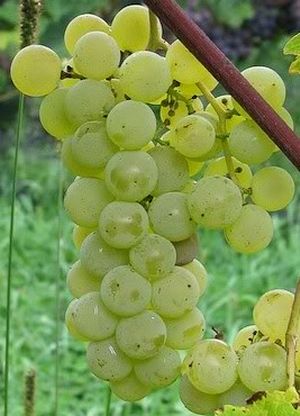 |
Louise Swenson
Louise Swenson is a white grape variety that was developed by Elmer Swenson, a renowned grape breeder. It is known for its cold tolerance and produces clusters of medium-sized berries that turn yellow-gold when ripe. The wine produced from this grape is light-bodied with a delicate aroma of honey and flowers.
Louise Swenson produces small to medium-sized clusters of round, medium-sized berries that turn yellow-gold when ripe. It has naturally low sugar with moderate acidity, wines are light-bodied with a delicate aroma of honey and flowers.Louise Swenson grapes, also known as Swenson Red, are a popular variety of grapevine for home gardeners. They produce clusters of large, sweet grapes that can be eaten fresh, dried into raisins, or made into wine. The vines are hardy and can thrive in most temperate climates. With proper planting and care, Louise Swenson grapes can provide a bountiful harvest for many years.
|
 |
Lucie Kuhlmann
A sister variety of Leon Millot that produces a slightly bigger crop and is earlier ripening. The wines are bold in colour but with lower tannins. Big and fruity, Luci Kuhlmann produces full flavoured dry red wines with berry fruit and smoky notes on the nose. On the palate, they are rich and often have slightly spicy finishes – a Nova Scotia red to enjoy with grilled beef or hearty stews.
Read more
|
 |
Marechal Foch
This grape is reliable, hardy and common in Nova Scotia vineyards. Refined and characterful, Marechal Foch produces medium to full-bodied red wines with distinctive berry and bell pepper aromas and flavours. Oak-aged versions offer a great balance of fruit character with dry, slightly tannic finishes –
|
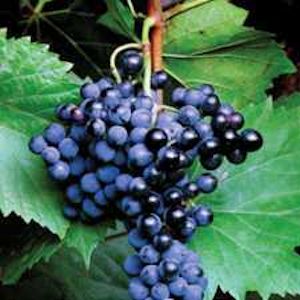 |
Marquette
Marquette is a red grape variety that was introduced in Quebec in 2008. Well resistant to disease, Marquette produces light, fruity and low tannic wines. It is the fourth most cultivated grape in Quebec. in the province.
Very popular with consumers – and its popularity is growing! – there are more and more fine and complex versions marked by accents of black fruits, spices and flowers.
In terms of its culture, the winegrowers notice that Marquette needs less degree-days (compared to other grape varieties grown in Quebec) to reach maturity. It also has good resistance to several diseases that affect grapes and vines.
Origin:Created at the University of Minnesota and marketed since 2006, it is the result of a cross between two other hybrids, Mn 1094 and Ravat 2621,2.
|
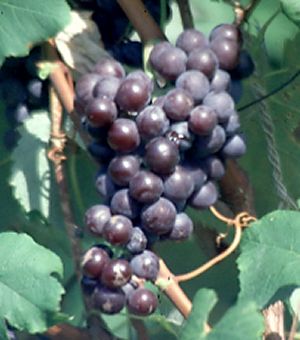 |
New York Muscat
This large, blue skinned grape was bred in Geneva, New York. It is intensely flavoured and extremely popular in Nova Scotia. The grapes are used in dry wines and Icewines. Bold and exotic, New York Muscat produces aromatic but dry full-bodied white wines with intense aromas of roses, grapefruit and exotic fruit such as lychee. has a labruscia like growth habit good hardiness and disease resistant mow yields but produces a nice wine.
|
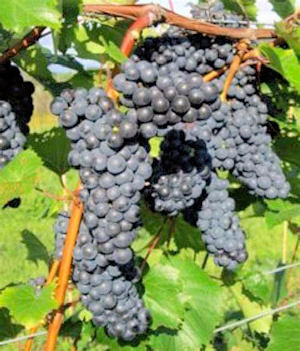 |
Petite Pearl
Petite Pearl is a recent variety of grape appreciated for its low acidity and its beautiful dark color which allows complex wines with high quality tannins.
This grape variety produces wines with good aging potential, with aromas of small red fruits, cherries, violets and fine herbs.
In Quebec, 52% of vineyards have at least one plantation of Petite Pearl and it is found on nearly 3% of the areas of Quebec vineyards.
Origin:Petite Pearl originated from Tom Plocher’s hybridization program in Minnesota (United States); it comes from a cross of MN 1094 and E.S. 4-7-26.
|
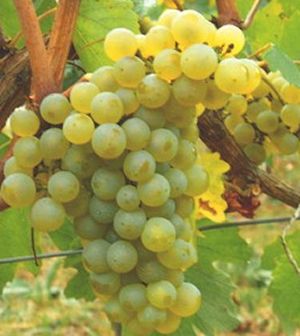 |
Pinot Gris
Pinot gris (also known as pinot grigio ) is a white wine grape variety of the species Vitis vinifera . Thought to be a mutant clone of the Pinot noir grape, it normally has a grayish-blue fruit, accounting for its name ( gris meaning "grey" in French) but the grape can have a brownish pink to black and even white appearance. The word pinot , which comes from the word meaning "pine cone" in French, could have been given to it because the grapes grow in small pine cone-shaped clusters. The wines produced from this grape also vary in colour from a deep golden yellow to copper and even a light shade of pink.
|
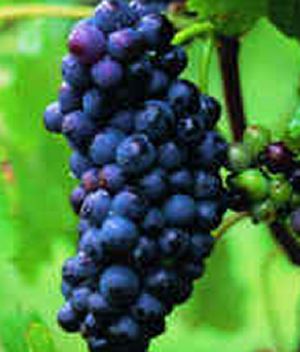 |
Pinot noir
( French: [pino nwa?] ) is a black wine grape variety of the species Vitis vinifera . The name may also refer to wines created predominantly from Pinot noir grapes. The name is derived from the French words for "pine" and "black" alluding to the grape variety's tightly clustered dark purple pine-cone shaped bunches of fruit.
Pinot noir grapes are grown around the world, mostly in the cooler regions, but the grape is chiefly associated with the Burgundy region of France . It is widely considered to produce some of the finest wines in the world, but is a difficult variety to cultivate and transform into wine.
Quality Pinot noir has been grown in Ontario for some time in the Niagara Peninsula and especially the Niagara-on-the-Lake and Short Hills Bench wine regions, as well as in Prince Edward County and on the north shore of Lake Erie . It has also been grown recently in the Okanagan , Lower Mainland , and Vancouver Island wine regions of British Columbia , the Annapolis Valley region of Nova Scotia and the Lanaudière and Brome-Missisquoi regions of Quebec
|
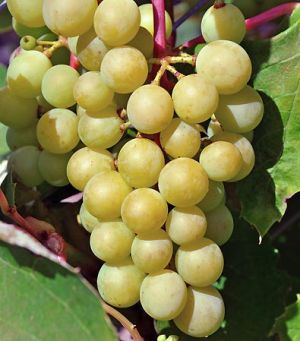 |
Prairie Star
Prairie Star is pale whitish green in colour and medium in size. It is a high-quality table grape, with about two seeds per grape, growing in long loose clusters. The fruit is agreeably flavoured with a good balance of sweetness and acidity. The taste reminds youof the flavours of honey and apple. As well as being used in fresh eating, it makes a flavourful juice and is used in wine-making. Prairie star generally ripens in mid-season, around late September.
Across bred between Apleglow and Elmer Swenson has the ability to with stand extreme cold.
|
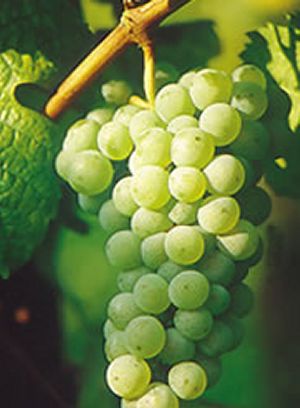 |
Riesling
Riesling is a white grape variety which originated in the Rhine region of Germany . Riesling is an aromatic grape variety displaying flowery, almost perfumed, aromas as well as high acidity. It is used to make dry, semi-sweet, sweet and sparkling white wines . Riesling wines are usually varietally pure and are seldom oaked . It is usually included in the "top three" white wine varieties together with Chardonnay and Sauvignon Blanc . Riesling is a variety which is highly " terroir -expressive", meaning that the character of Riesling wines is clearly influenced by the wine's place of origin.
|
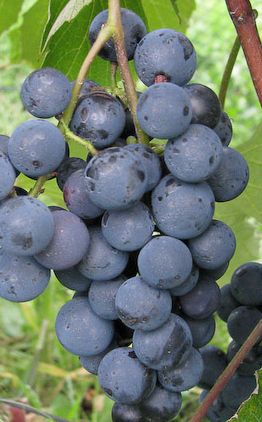 |
Sabrevois
Sabrevois is a red grape variety that is a sister variety of St. Croix with better winter hardiness It is a complex interspecific crossbreed between Alpenglow and Elmer Swenson that produces small red wine grapes that are highly perishable and best used when still firm.3. The wine produced from this grape is typically light-bodied and has a pleasant fruitiness lacking in body and tannins, making it a good candidate for blending with other complimentary red hybrids
|
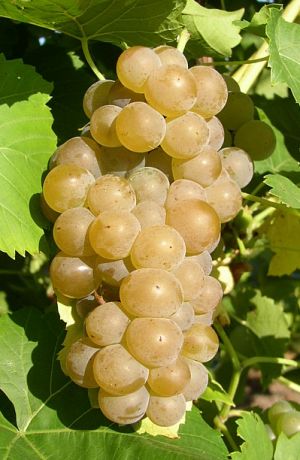 |
Seyval Blac
This grape is hardy and versatile and performs well in Nova Scotia's warmer regions. Crisp and clean, Seyval Blanc produces light to medium-bodied white wines with crisp citrus fruit aromas and flavours– has a sweet and clean bouquet reminiscent of pears and citrus fruit
a great - aperitif or to enjoy with simply prepared mussels or light white fish such as sole.
know as Seyve-Villard 5-276 hybrid
Seyval Blanc was created either by Bertille Seyve , or his son-in-law Villard, as a cross of Seibel 5656 and Rayon d'Or (Seibel 4986
|
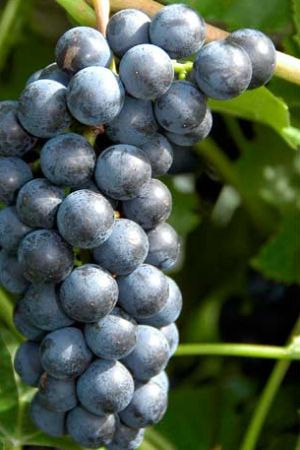 |
St Croix
An American variety, St. Croix produces fruity, delicate red wines with low acidity.
With a beautiful color, this grape offers low tannins, but very pleasant! It is also appreciated for its fruity rosés and fortified wines.
Did you know it also makes great seeded table grapes?
Origin: American in Minnesota and descended from E.S. 283 and E.S. 193, the St. Croix was selected by Elmer Swenson in the early 1980s.
|
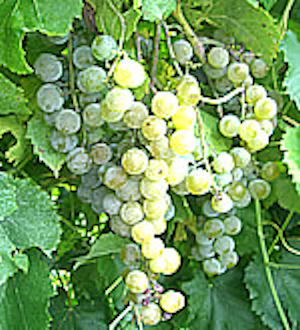 |
St Pepin
is a modern hybrid variety of wine grape, mostly grown in North America. It produces grapes suitable for making fruity white wines similar to Riesling or as a base for blended wines. The grapes also make a good seeded table grape for eating. It has the benefits of early ripening and when hardened properly in the fall it is winter hardy to at least −25 °F (−32 °C). As such, it best suited to growing in more northern climates.
St. Pepin was breed by Elmer Swenson c. 1970 and released in 1986. It is a hybrid of the male Seyval blanc crossed to a seedling of Minnesota 78 by Seibel 1000 (a.k.a. Rosette). Unlike most modern grapes, it is a pistillate female and so needs to be planted next to male vines from a close sibling variety to achieve pollination.
|
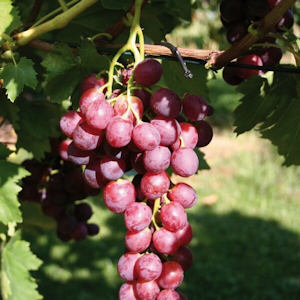 |
Swenson
Marketed since 1994, Swenson White offers very fragrant white wines, with a well-pronounced and complex flowery nose.
Winemakers appreciate the cold and disease resistance of Swensen White: the yellowish, thick-skinned fruits, which allow them to cling to the vines, unimpeded by insects, late in the fall season. Also making Swenson White a good candidate for ice wine.
Origin: Native to Osceola, Wisconsin, USA, Swensen White was bred from a cross Edelweiss X ES 442.
|
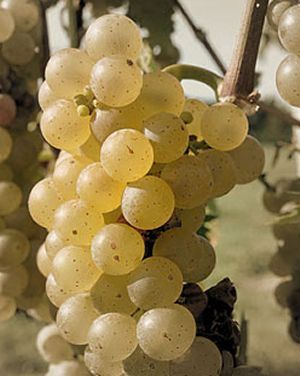 |
Vidal Blanc
Vidal Blanc is a very winter-hardy variety that manages to produce high sugar levels in cold climates with moderate to high acidity . It is grown extensively in the Canadian wine regions of Ontario, British Columbia, Quebec, and Nova Scotia, where it is often used for ice wine production as a permitted grape of the Vintners Quality Alliance . It is also grown widely throughout the United States, where it is used to produce both dry and sweet wines in several states, including Michigan, Virginia, Missouri, and North Carolina .
The wine produced from Vidal Blanc tends to be very fruity, with aroma notes of grapefruit and pineapple Due to its high acidity and sugar potential, it is particularly suited to sweeter, dessert wines.n particular, because of the tough outer skin of the fruit, it is well adapted for the production of ice wine
|
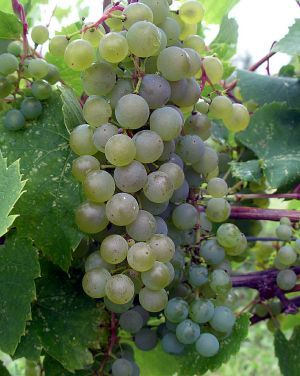 |
Vandal-Cliche
The Vandal-Cliche grape is a hybrid variety that was developed by Joseph O. Vandal at Laval University in Quebec, Canada in 1946 1. It is an early to medium ripening vine that is highly resistant to frost, but susceptible to downy mildew and anthracnose . Wines made from this grape are light-colored white wines with citrus aromas and a foxtone .
It is used in the production of white wines at several wineries in Quebec, including Vignoble Couchepagane . The grape’s hardiness allows it to withstand cold temperatures down to -35C
Vignoble Clos de la Montagne
Vignoble la ache a Maxime
Vignoble Domaine Royarnois
Vignoble Isle de Bacchus
Vignoble de Sainte-Petronille
Vignoble Carone
Vignoble Domaine de l'Ile Ronde
Vignoble de la Riviere du Chene
Vignoble La Roche des Brises
Le Vignoble Du Clos Baillie
|
The Kay Gray produces white to golden-coloured grapes that are great for fresh eating, juicing and winemaking. Its flavour varies from a rather ordinary labrusca to a pleasant fruity flavour, depending on where it is grown. It’s a vigorous grower producing many medium-sized clusters of compact grapes. The grapes average around 3.5 grams in weight. Ripens around early to middle of September in most years. Vines begin to produce fruit within 3 years after planting.
Kay Gray Grape has very good resistance to disease and is preferred by organic grape growers. Bred by Elmer Swenson in Osceola, Wisconsin. Found almost by accident: one year Mr. Swenson was ill and didn't spray his vineyard. There was one seedling vine that stood out for its health and resistance to disease that struck the other vines. Later he named it Kay Gray and introduced it in 1981.
ontreal Blues is one of the many varieties created by renowned grape breeder Elmer Swenson in Osceola, Wisconsin, as part of his effort to breed cold hardy grapes suitable for growing in the colder climates of North America. This variety was released in 1998 and in some areas is also known as St. Theresa, named for Saint Therese of Lisieux who was a French nun who planted flowers to show her love of God.
Why We Grow It: This variety produces large clusters of blue, Concord-like grapes with a nice, mild sweet flavour. They are quite cold hardy and can be made into pies, jams, or juice!
Please see : Ontario ~ Nova Scotia ~ Quebec ~ New Brunswick ~ Newfoundland
British Columbia
winebell@outlook.com
winebob49@gmail.com

Welcome to Robert Bell's Winesofcanada.com ! This is a personal website. We do not represent the wine industry or any aspect of the Canadian Government. We have been promoting Canada's wines and wineries since 1992. We do not sell or purchase any products. Please enjoy the website. There is a more detailed sitemap. Your comments are welcome.
As the cost of living continues to rise, the cost of maintaining this website has tripled in the last two years alone our non-profit website would welcome a little support!
A small donation would be greatly appreciated.
|
Home | About | Sitemap |Quebec Wineries |New |Support | Contact
Us |©2024 Robert A Bell
|






























